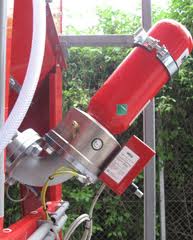Difference between revisions of "Explosion Suppression Systems"
| Line 26: | Line 26: | ||
==Videos== | ==Videos== | ||
<youtube> | <youtube>_UP3NqGAE1Q</youtube> | ||
<youtube>oP4OPbRDV9A</youtube> | <youtube>oP4OPbRDV9A</youtube> | ||
Latest revision as of 05:55, 20 February 2013
Explosion Suppression systems are designed to detect and chemically suppress an explosion in its earliest (incipient) stages. Explosion pressures reach dangerous levels in less than 50 milliseconds, and with unique detector technology, the deflagration can be detected in less than 1 millisecond!
Explosion Suppression technology is a complex field involving a wide variety of systems, chemistry and agents.
An explosion suppression system consists of three components, and optionally, a fourth. Preceeding a deflagration, a pressure wave ripples out from the epicenter of the explosion. Explosion suppression systems use pressure sensor detectors to detect and act upon the developing explosion. A good pressure sensor will detect a sharp increase in pressure in one millisecond.
The control panel receives the detection signal from the pressure sensors and then sends a release signal to the container containing fire suppressant. The elapsed time from receipt of detection to transmission of the release command is less than one millisecond.
Fire suppressant containers hold fire suppressing agents, and release the agent at the command of the control panel. Since explosion pressures can reach dangerous levels in less than 50 milliseconds, the agent must be released and dispersed in a matter of milliseconds. Suppressant agents typically include Carbon Dioxide, FM-200, and water mist.
Opitionally, an explosion suppression system may contain either a mechanical or chemical isolation system to prevent flame or pressure from traveling though connected ducts or piping into other process equipment. Isolation is usually complete within 5 milliseconds of detection.
Advantages
- Extinguishes the flame within the equipment, preventing fire damage.
- "Zero restriction" dispersion nozzles to reduce response time and increase agent discharge velocity.
- For added reliability, the control circuit designs provide continued service even if two of the wires become severed by some type of facility upset.
- Suppresses Class ST III dust explosion hazards - offering your business the highest level of industrial explosion protection.
- Prevents pressure piling and secondary explosions with interconnected equipment.
- Retains toxic or valuable material within the process equipment.
- Integrates with the process controls to enable other protection devices, process shutdown, and remote annunciation devices.
- Uses gas cartridges instead of explosive charges to release suppressant, providing a safer, more reliable initiation device with longer service and shelf life.
Videos
